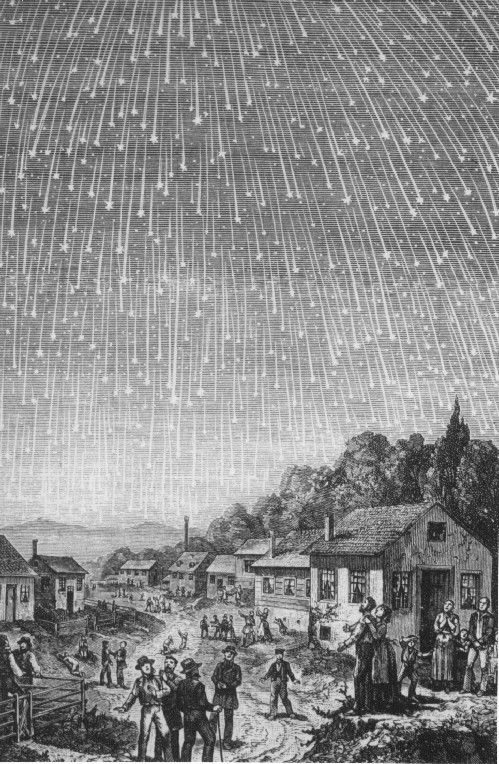Leonid Meteor Shower 2014: History and Visibility of Comet Tempel-Tuttle's Fiery Cosmic Debris

The night sky will be lit up by a display of shooting stars tonight, as the Leonid meteor shower makes its annual appearance.
Visible overnight between 17 and 18 November, up to 15 meteors expected to be visible per hour during the Leonids. For the best chance of spotting a meteor, skywatchers should find a quiet spot with little light pollution.
For those unable to see the event, the Slooh Community Observatory will host an online live streaming of the show - which can be seen here. Astronomers at Nasa's Marshall Space Flight Center in Huntsville, Alabama, will also offer a live webcast of the shower, via a telescope and a Ustream feed.
This is a small shower in comparison with previous appearances of the historic Leonids, during which thousands of meteors per hour have streaked across the sky. In 2002, National Geographic reports, the last major Leonid shower saw around 3,000 meteors per hours across the sky.
Will we be able to see the Leonids?
Dr John Mason, of the British Astronomical Society, told IBTimes UK: "It depends entirely on the weather, you need a very clear sky with no light pollution in order to see the meteor shower properly."
"If it is good, you will see between 10 and 15 per hour, but not if the night sky is obscured by lights, so you won't see much from a city."
"The Leonids are spectacular every 33 years or so, when the parent comet is nearby. The best time to see the shower in the UK is between 2am and 4am."
"We're predicting 10 to 15 meteors per hour," Dr Bill Cooke of the Meteoroid Environmental Office at Nasa's Marshall Space Flight Center, told Space.com. "For best viewing, wait until after midnight on 18 November (for US viewers), with the peak of the shower occurring just before sunrise."

Where did the meteor shower come from?
The parent body of the shower is the comet Tempel-Tuttle, a Halley-type comet with an orbital period of 33 years. It was discovered by Gottfried Kirch in 1699, but was not recognised as a periodic comet until the discoveries by William Tempel and Horace Tuttle during the 1866 perihelion – the point in the orbit of a planet, asteroid or comet when it is nearest to the sun.
Shooting stars appear in the sky when the Earth passes through the cosmic debris field left behind by the comet. When the debris comes into contact with our planet's atmosphere, it burns - creating an impressive display.
The Leonids are a fast-moving stream which encounter Earth's trajectory and impact at approximately 72 kilometres per second. Larger Leonids, measuring around 10mm across, have a mass of half a gram and are known to deposit bright meteors.

The name of the shower comes from the location of their radiant in the constellation Leo, in between Cancer in the west and Virgo in the east, where the meteors appear to originate from.
How long is the cycle of the Leonids?
The shower occurs annually, a storm takes place every 33 years, around the 17 November, when the shower is at its most visible.
During these storms, thousands of meteors can be seen per hour. One such storm occurred in 1833, when over 1,000 meteors could be seen shooting across the night sky in a spectacular cosmic display.
A meteor storm is "a very rare event where there was an outburst of much greater activities than would normally be expected," operations manager of the American Meteor Society, Mike Hankey, told Newsweek.
According to Scientific American, the next big Leonid shower will occur around 2034.
Why are they so famous?
The Leonids are famous because their storms can be among the most impressive meteor showers, with thousands of meteors visible at once.
The profilic storm in 1833 sparked the development of scientific study of meteors and meteor showers, which was previously thought to be atmospheric phenomena.
It was recorded by many across the US, including Native Americans. The founder and first leader of Mormonism, Joseph Smith, noted in his journal that the shower was a literal fulfilment of the word of God – which he took as a sign that the coming of Christ was imminent. The Leonids have been repeatedly documented throughout history since 900 AD.
Denison Olmstead, a US astronomer and physicist, spent the last weeks of 1833 collecting information on the storm. Presenting his findings in January 1834 to the American Journal of Science and Arts, he noted that the shower was of short duration and appeared to radiate from the constellation of Leo. Olmstead speculated that the meteors came from a cloud of particles in space.
© Copyright IBTimes 2024. All rights reserved.







